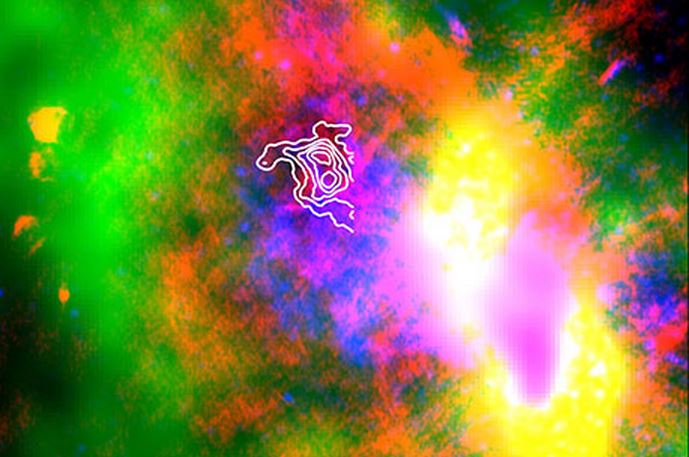An infrared telescope fitted onto a Boeing 747 detected a supernova cosmic dust factory – producing the stuff that forms planets like the Earth and stars like the Sun – in the center of our Milky Way, researchers from Cornell University reported in Science Express.
Lead author Ryan Lau, Cornell postdoctoral associate for astronomy, said:
“Dust itself is very important because it’s the stuff that forms stars and planets, like the sun and Earth, respectively, so to know where it comes from is an important question.”
“Our work strongly reinforces the theory that supernovae are producing the dust seen in galaxies of the early universe.”

Peering into the center of our galaxy, in this false color image, contour lines reveal the dusty area of Sagittarius A East – remnant of an ancient supernova. (Image: Cornell University)
Astronomers have been wondering for decades how galaxies, which were formed as recently as 1 billion years after the Big Bang, had so much cosmic dust.
They have theorized that supernovae – exploding stars, the largest possible explosion in the Universe – contain huge amounts of metal-enriched material that, in turn, carries key ingredients of dust like carbon, iron and silicon.
The astrophysicists examined a 10,000-year-old supernova remnant near the center of the Milky Way called Sagittarius A East.
Dr. Lay explained that when a supernova explodes, its core materials expand and form dust. Scientists have observed this in many young supernova remnants, such as Cassiopeia A and SN1987A.

An artist’s impression of a supernova. (Image: Wikimedia)
Dust can survive turbulent supernova environment
Scientists expect the churning dust to be destroyed in the turbulent supernova environment – that is, in theory.
Dr. Lau said:
“There have been no direct observations of any dust surviving the environment of the supernova remnant … until now, and that’s why our observations of an ‘old’ supernova are so important.”
The observations were captured via FORCAST (the Faint Object Infrared Camera Telescope) aboard a modified Boeing 747 (SOFIA – the Stratospheric Observatory for Infrared Astronomy), and a joint project of the Universities Space Research Association, NASA and the German Aerospace Center. It is the largest airborne astronomical observatory in the world.
There is currently no space-based telescope that can observe far-infrared wavelengths, while ground-based telescopes, due to the Earth’s atmosphere, cannot observe light at these wavelengths.
In an Abstract in the journal, the authors concluded:
“The results suggest that supernovae may indeed be the dominant dust production mechanism in the dense environment of early Universe galaxies.”
Dr. Lau’s colleagues in this research include co-authors Mark Morris from the University of California, Los Angeles, Zhiyuan Li from Nanjing University in China, Terry Herter from Cornell University, and Joe Adams from the NASA Ames Research Center.
Citation: “Old supernova dust factory revealed at the Galactic center,” R. M. Lau, T. L. Herter, M. R. Morris, Z. Li, and J. D. Adams. Science. Published online 19 March, 2015. DOI:10.1126/science.aaa2208.
